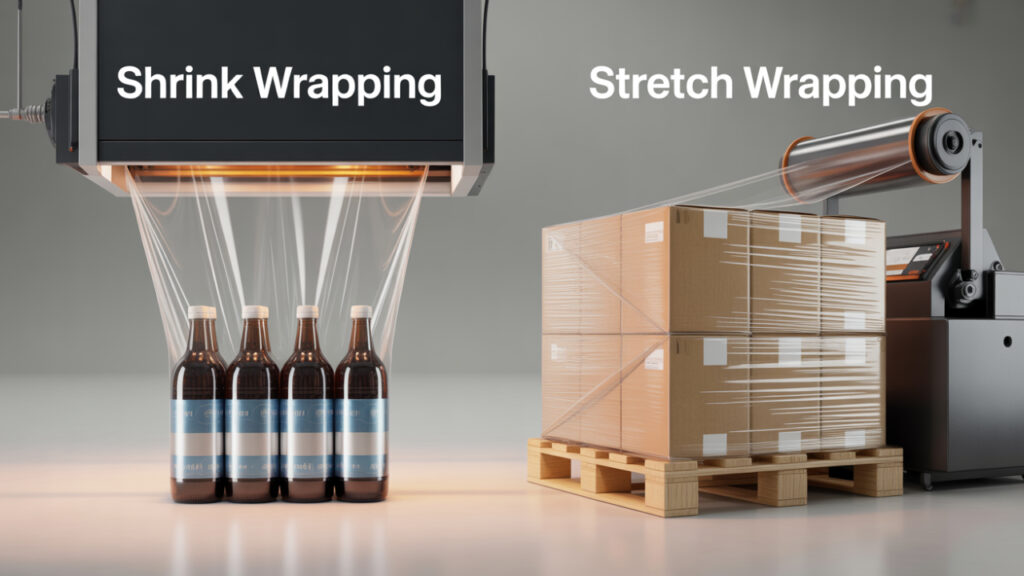Shrink Wrapping vs Stretch Wrapping – Which One to Choose?
Great packaging is not just about putting your product in a box. This is only your first line of defense against your product getting damaged or getting stolen and, in turn, generating zero revenue. Still, multiple businesses have to choose between shrink wrapping vs stretch wrapping, thus leading to costly mistakes. When you look into shrink wrap vs stretch wrap, it leads towards costly mistakes. For shrink wrap’s sleep that finishes towards investment. Does the stretch wrap make smarter picks? Let’s just start with our confusion for a no-jargon comparison.
What is shrink wrapping?
- The product that’s placed for loose plastic sleeves.
- This passes through a heat tunnel (or is blasted towards it with a heat gun), shrinking that film snugly around it.
- The result? A smooth and tamper-proof seal for showcasing the product.
Where these shine
- FMCG & Retail: Snack multipacks, bottled beverages, and cosmetics.
- Pharma: Blister packs and for medicines that need sterile & dust-proof protection.
- Examples: An 8-pack of shampoo bottles wrapped in glossy film—retail ready and impossible to open without any kind of damage.
What is stretch wrapping?
Stretch wrapping generally secures different items through the use of stretching films that are elastic in nature—as in LLDPE—and does not use heat to do that. The process of stretch wrapping involves:
- Goods being palletized sit on a turntable.
- A rotating arm that’s attached to the machine stretches that LLDPE film fully around the load.
- The tension of that film holds goods in place during the transit process.
Where This Works:
Logistics and Warehousing: Canned goods in pallet-waypackaging, heavy machinery, and stacked cartons.
Bulk Shipping: Furniture, steel coils, or appliances create
Example: A bigger pallet of around 50 cereal boxes can be wrapped in stretch films and can be transported across long routes.
tretching films that are elastic in nature—as in LLDPE—and does not use heat to do that. The process of stretch wrapping involves:
Difference between shrink and stretch wrapping
Let’s look at the key differences between shrink wrapping vs stretch wrapping in a tabular form for easy and fast understanding.
| Features | Features Shrink Wrapping | Stretch Wrapping |
|---|---|---|
| Methods | Heat Shrinking on the product | Mechanical film stretching around/on load. |
| Great for | Smaller articles like Electronics, bottles, etc | Bigger pallets or bulk shipments |
| Costing | Higher costs ( Requires Energy + Heat tunnels) | Lower Costs - Basic Machine + Film |
| Speed | Medium Speed (heat application requires time) | Quick ( around 60 pallets/hr) |
| Tamper Evidence | Yes (Film can easily break open and cannot be remodelled ) | No ( Can be reapplied and reopen easily) |
| Display Appeal | High ( Product visibility, glossy) | Loose film and not retail ready |
When you look at the differences for shrink vs stretch wrap, both have different use cases and require different solutions to work.
Pros and Cons: The Real Deal
- Choose shrink wrapping if:
Your product has to go on a retail shelf (e.g., cosmetics, snacks).
Tamper-proof is not negotiable (premium goods, pharma).
Your prioritization is brand image, and you do not consider swift delivery.
- Choose Stretch Wrapping if:
You have to move goods in pallet form to different warehouses.
Budget constraints and speed are important to you.
Loads are irregular/heavy (furniture, steel, appliances).
Still confused? Ask yourself this question: “Will customers see this packaging?” If yes, then choose shrink wrapping; otherwise, go with stretch wrapping.
DIPACK’s Packaging Solutions: No Guesswork Needed
- Shrink Wrapping: Our L-bar sealers can easily create bundles that are retail-ready for FMCG sectors (like snack multipacks or bottled beverages), thus reducing the film wastage by around 22% through the use of advanced precision control along with tension control.
- Stretch Wrapping: Rotary arm machines that can easily wrap around 55+ pallets/hour—great for all those e-commerce giants for nationwide delivery. The machines can handle unstable loads, such as furniture, ensuring zero shifting and reducing transit damage claims by approximately 32%.
All these solutions, whether you choose shrink wrapping or stretch wrapping or any other packaging solution, come with 24X7 free site assessments, plus complete technical support, along with the compatibility with the recycled eco-films (cutting the carbon footprint by around 18%).
Still unsure? Simply talk to our experts, and we will provide the perfect machine in just 15 minutes, backed by real-world case studies from the particular industries.
Conclusion: Stop Overcomplicating Packaging
The major difference between shrink and stretch wrapping generally comes down to one major question. Who can see the package?
Choose shrink wrap if your stuff goes onto the retail shelf and customers can see your products. Otherwise, choose stretch wrapping for better logistics and pallet wrapping needs. Ignoring these factors can waste money, resources, and your manpower that handles these tasks.
Ready for the advanced and effective wrapping? Simply get in touch with DIPACK for all your packaging needs. Connect today! And find the right packaging solutions that can boost your packaging process.


